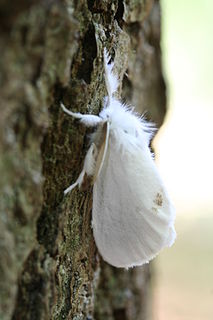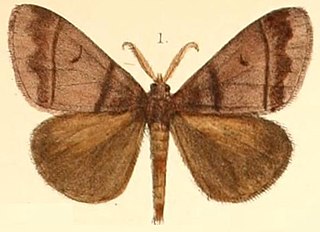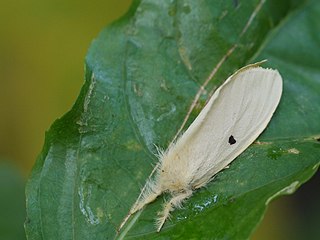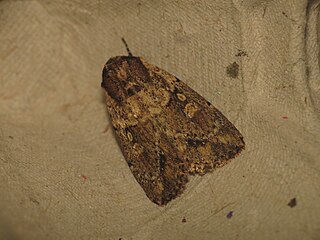Related Research Articles

The yellow-tail, goldtail moth or swan moth is a moth of the family Erebidae. The species was first described by Johann Kaspar Füssli in 1775, and has commonly been placed within the related genus Euproctis. It is distributed throughout Europe to the Urals, then east across the Palearctic to Siberia and south to India and Sri Lanka.

Delgamma is a monotypic moth genus of the family Noctuidae erected by Frederic Moore in 1885. Its only species, Delgamma pangonia, the strawberry cutworm, was first described by Achille Guenée in 1852.

Euproctis is a genus of tussock moths in the family Erebidae described by Jacob Hübner in 1819. Species are cosmopolitan, widespread throughout Palearctic, African, Oriental and Australian regions. Molecular phylogenetic studies indicate that the genus as presently understood comprises a large number of unrelated lineages, only a few of which have names, and is therefore in serious need of revision.
Artaxa angulata is a moth of the family Erebidae first described by Shōnen Matsumura in 1927. It is found in Taiwan, Myanmar, India, Pakistan, Sri Lanka, Malaysia, Singapore and Indonesia.
Cispia alba is a moth of the family Erebidae first described by Frederic Moore in 1879. It is found in Sri Lanka.
Sphrageidus xanthorrhoea is a moth of the family Erebidae first described by Vincenz Kollar in 1848. It is found in India, Sri Lanka, Java and Indonesia. It was once classified under the genus Euproctis, where it is accepted by some authors.
Euproctis bimaculata is a moth of the family Erebidae first described by Francis Walker in 1855. It is found in India, Sri Lanka and Thailand.

Euproctis cervina is a moth of the family Erebidae first described by Frederic Moore in 1877. It is found in Sri Lanka.
Euproctis fraterna is a moth of the family Erebidae first described by Frederic Moore in 1883. It is found in the Maldives, India, Sri Lanka and the Seychelles.
Euproctis fulvipuncta is a moth of the family Erebidae first described by George Hampson in 1893. It is found in India and Sri Lanka.

Euproctis lunata, the castor hairy caterpillar, is a moth of the family Erebidae. The species was first described by Francis Walker in 1855. It is found in India, Pakistan, Sri Lanka and Thailand.

Euproctis latifascia is a moth of the family Erebidae first described by Francis Walker in 1855. It is found in India, Sri Lanka and Taiwan.
Euproctis semisignata is a moth of the family Erebidae first described by Francis Walker in 1865. It is found in India and Sri Lanka.

Euproctis varians is a moth of the family Erebidae first described by Francis Walker in 1855. It is found in India, Sri Lanka, the Maldives, Celebes and China.
Lymantria todara is a moth of the family Erebidae first described by Frederic Moore in 1879. It is found in India (Nilgiri) and Sri Lanka.
Cusuma vilis is a moth of the family Geometridae first described by Francis Walker in 1854. It is found in Sri Lanka.
Dysphania prunicolor is a moth of the family Geometridae first described by Frederic Moore in 1879. It is found in India and may be found in Sri Lanka.

Craniophora fasciata is a moth of the family Noctuidae first described by Frederic Moore in 1884. It is found in Sri Lanka, Japan, Korea, Taiwan, Thailand and Australia.
Avitta rufifrons is a moth of the family Noctuidae first described by Frederic Moore in 1887. It is found in the Indian subregion, Sri Lanka, New Guinea, and Queensland, Australia.

Mythimna reversa is a moth of the family Noctuidae first described by Frederic Moore in 1884. It is found in the Indian subregion, Sri Lanka, Borneo, the Philippines, Hong Kong, Malaysia and Australia.
References
- ↑ "Species Details: Euproctis howra rhoda Swinhoe, 1891". Catalogue of Life. Retrieved 7 March 2018.
- ↑ Koçak, Ahmet Ömer; Kemal, Muhabbet (20 February 2012). "Preliminary list of the Lepidoptera of Sri Lanka". Cesa News. Centre for Entomological Studies Ankara (79): 1–57 – via Academia.
- ↑ Savela, Markku (ed.). "Euproctis howra (Moore, 1879)". Lepidoptera and Some Other Life Forms. Archived from the original on 11 March 2016. Retrieved 8 October 2018.
- ↑ "Genduara rhoda". CSIRO - Australian Moths Online. Retrieved 8 October 2018.
- ↑ "HOSTS - a Database of the World's Lepidopteran Hostplants". The Natural History Museum. Retrieved 7 March 2018.